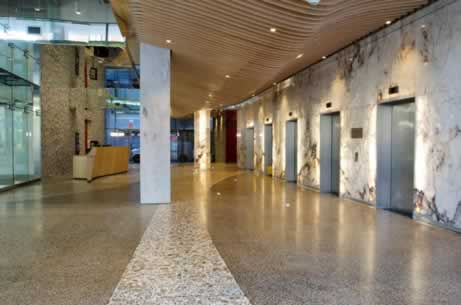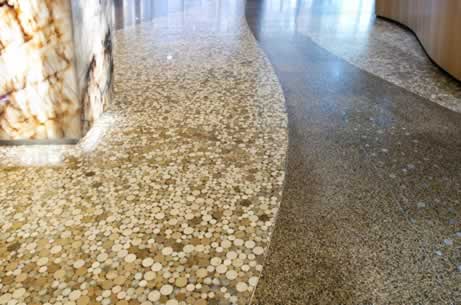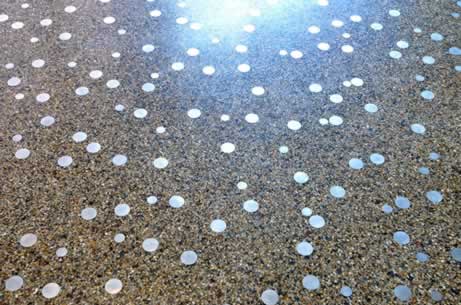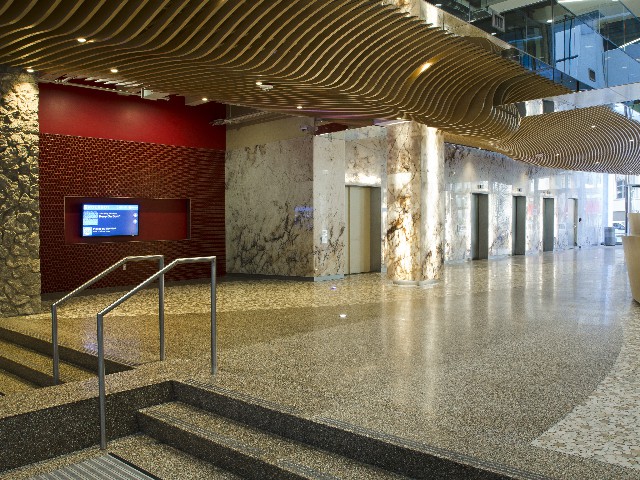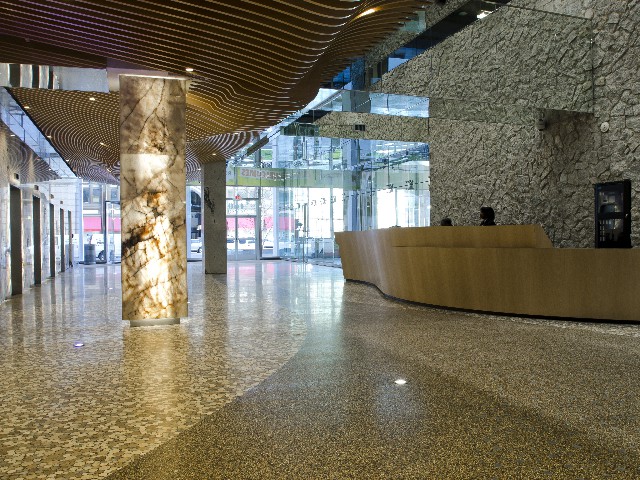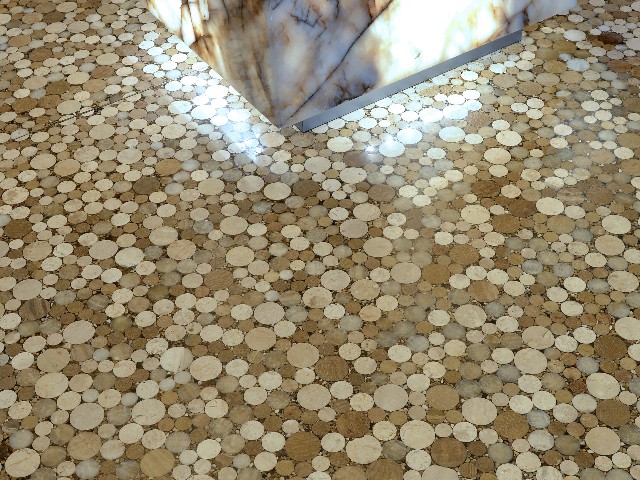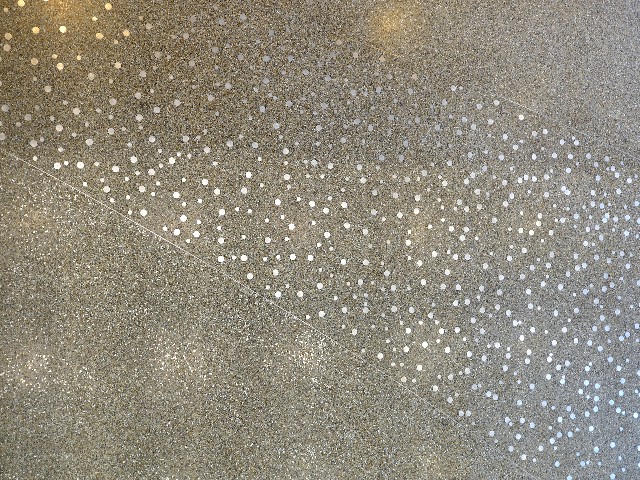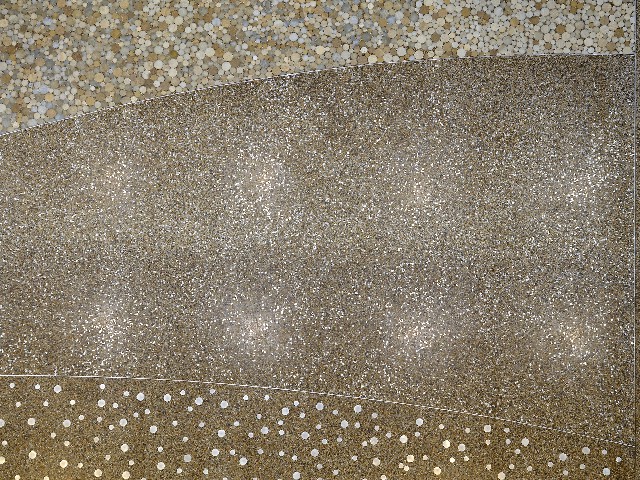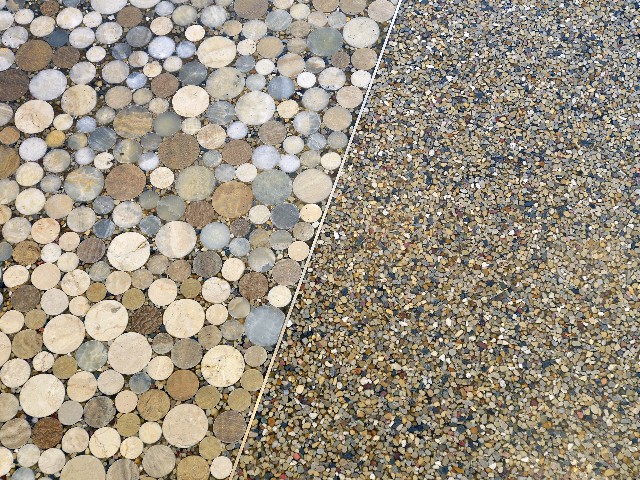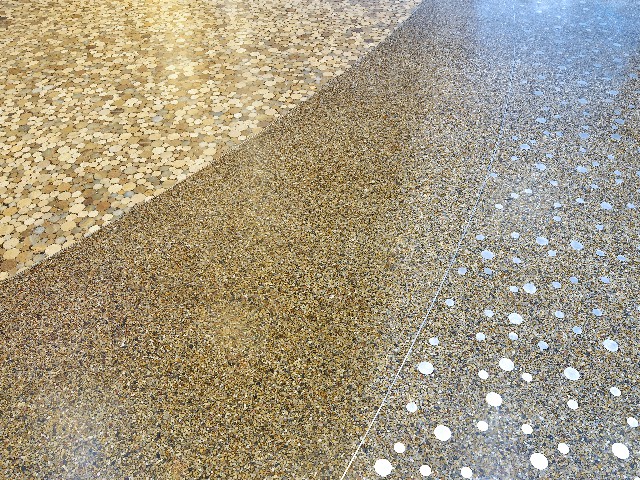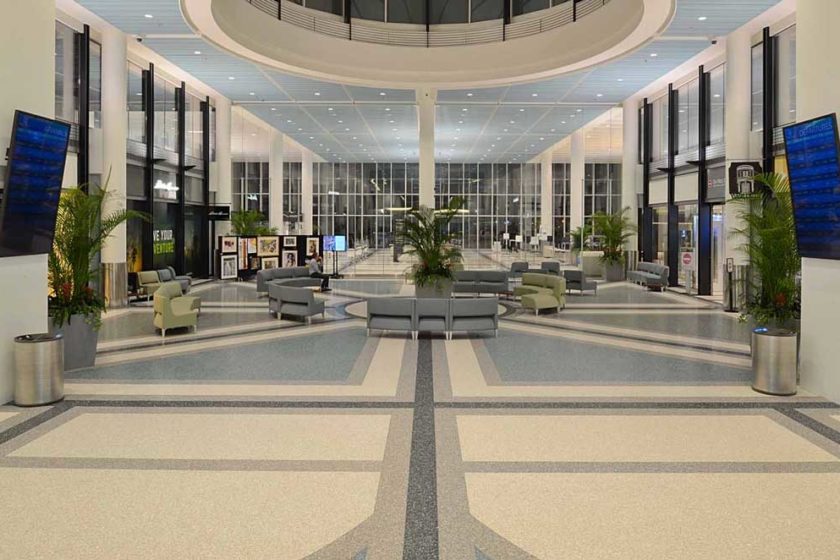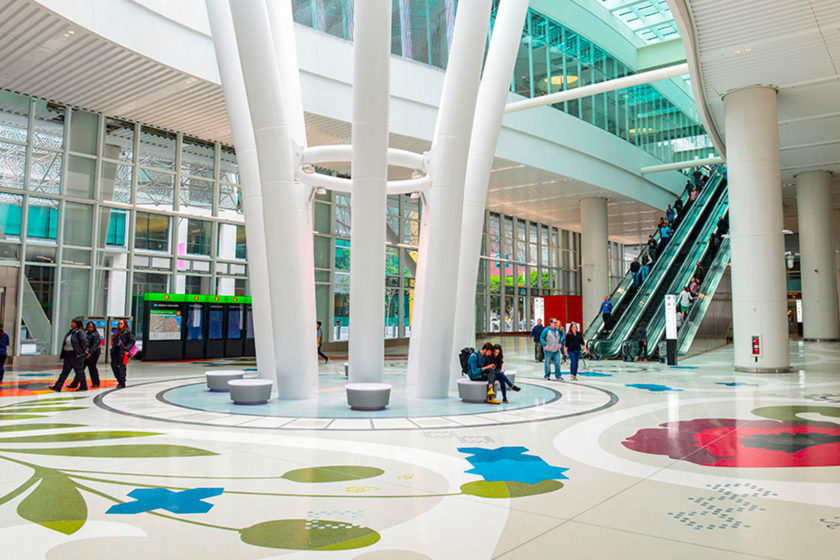Award Winning Renovation of Yamasaki Design
Detroit’s first major structure built post-WWII, the Federal Reserve Bank of Chicago annex was also the city’s first venture into modern era architecture and its first curtain wall structure. The building, in the forefront nationally of the Modern Movement, was also one of Minoru Yamasaki’s first interior/exterior designs with an outdoor landscape plaza that came to characterize his later work. A Detroit-based architect, best known today as the designer of the World Trade Center twin towers, Yamasaki left his mark throughout the Detroit area. The Federal Reserve’s 1951 annex with its front plaza, built before Yamasaki (1912-1986) established his reputation in his own practice, was designed to be a refreshingly tranquil interlude in the city landscape. The building’s award-winning 2013 renovation successfully captures Yamasaki’s ideals of surprise, serenity and delight.
An innovative application of terrazzo plays a major part in a design that honors the architectural and historical significance of the Federal Reserve annex through the materiality and modern functionality of the present day. River rock and other atypical aggregates suspended in clear epoxy resin recreate a permanent natural Zen garden. Its stylistic raked gravel and the serpentine lines, as of a sandy river, connect organically to the renovated outdoor plaza.
Terrazzo installers on the project, Artisan Tile of Brighton, Mich., garnered a 2014 Honor Award from the National Terrazzo & Mosaic Association for the project. Entries are evaluated on the role of terrazzo within the scope of the structure’s design and on excellence in workmanship.
Kelly Deines, IIDA LEED AP, lead designer on the project, considered the use of natural materials the key to creating “a collaboration with Yamasaki’s spirit” for the historic renovation. That it was a Yamasaki building and plaza drove the design of the entire renovation, stated Deines, principal and creative director for Rossetti Architecture of Detroit. His aim was to “metaphorically connect to the design and materials of mid-century that changed the look of architecture.”
Raw Materials
The Federal Reserve Bank as handed to the project architects was a complex of two connected steel frame buildings in downtown Detroit’s Financial Historic District. The original marble-front, Neoclassical-style bank was built in 1927. Headed into renovations, Yamasaki’s eight-story International style annex in glass and marble was dismissed in local press as “scarily drab.” The 176,000-square-foot property had been vacant since 2004. Renovation plans specified a bright, open retail space on the ground floor, with eight floors of modern office space.

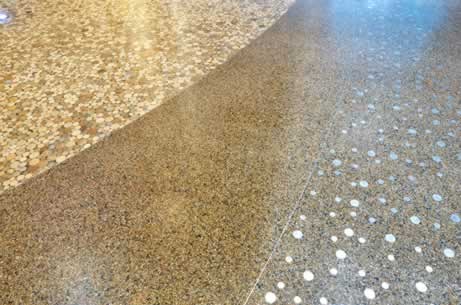
Design Directions
The design intention was a delicate balance, carried out under the vigilance of Detroit Historic District Commission. Deines wanted the permanence and ease of maintenance that the poured-material process of terrazzo supplies, but the look he had in mind called for richer matrix colors than is typical of traditional terrazzo applications. The creative choice of transparent epoxy resin, leaving blended river rock and other aggregates apparent as in a shallow stream, achieves the intended Zen-style atmosphere.
The new terrazzo floors in seven elevator lobbies, a total of 7,500 square feet, incorporate the resin and river rock combination. In the mezzanine and main levels, that basic blend is carried through as the common denominator in the in the four different design mixes. Incorporating orbital marble tile, angular metal shavings or two different sizes of metal discs with the metal fragments sounds notes of technology and machining within the theme of nature.
This experience working with terrazzo “stretched our imagination, certainly. It got us thinking more of the materiality and of expanding aggregates beyond Italian marble remnants,” Deines recalled.
“It’s about suspension: ‘What can I suspend in an epoxy binder?’” he continued. “Material that can survive being ground down and not pop out. Really, anything goes.”
Installation Challenges
Because of the existing elevations in the elevator lobbies, the original cement terrazzo had to be removed by a demolition crew and the substrate leveled to make way for the new terrazzo. Installation took just over two months and was completed Sept. 18, 2013.
The liquidity of the transparent resin combined with the circular river rocks and minimal use of divider strips made for an extremely challenging installation, reported Artisan Tile president Jennifer Panning. The resin was hard to contain even between divider strips. The orbital marble tiles had to be set first and the river rock carefully embedded by hand between the stones. The metal disks were also individually handset after the pebbles were troweled out and before the design mix was poured. Grinding the variety of surfaces presented its own set of challenges.
Renovated Results
The addition of glass in the interior lobby meeting the outdoor plaza emphasizes Yamasaki’s blurring of the delineation of indoors and out. The site plan’s lines flow continuously into the plaza’s planting modules. The same pea gravel of the terrazzo floors is carried into the plaza loose in the planter beds set in the existing stone work.
“One is suspended and durable, the other gets rained on out in nature,” Deines said. The result? A note of refreshing serenity in the city landscape. “Like Yamasaki’s ghost wisping through,” noted Deines.
“It has a natural quality, reminiscent of Arte Povera,” he observed, literally, poor art. “Every day materials, not necessarily rich, but when manipulated in a different context are transformed into art.
Most people don’t see it as common garden gravel and aluminum and travertine; because of the application it reaches the level of art. It’s really beautiful.”
The architect noted that the success of the design is based on the entire experience of the place founded on the harmony of the elements. Deines speaks from daily experience: Rossetti Architecture was the first office occupant of the newly renovated annex, claiming space on the fourth floor.
“Terrazzo is one of many characters in the story with so much going on, with beautiful ceilings and walls, also,” Deines explained. “Terrazzo is a great material to begin the story, to play a major role, a star character or a stunt man. It doesn’t steal the show; it absolutely plays its role.”
